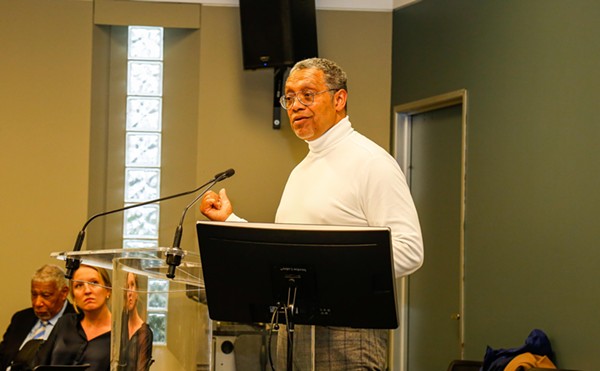[
{
"name": "Ad - NativeInline - Injected",
"component": "38482495",
"insertPoint": "3",
"requiredCountToDisplay": "5"
},{
"name": "Real 1 Player (r2) - Inline",
"component": "38482494",
"insertPoint": "2/3",
"requiredCountToDisplay": "9"
}
]
The fifth episode of Serial's Cleveland-based third season focuses centrally on prosecutor Brian Radigan and on the office of the prosecutor generally: its history, its power.
Picking up where episode four left off, host Sarah Koenig discusses the Avielle Wakefield case with Radigan. What led to suspect Davon Holmes' dismissal, she wants to know? What was the evidence against him in the first place, and what made the case collapse?
Koenig notes how alarming it is that no one seems all that bothered by the fact that Holmes spent a year behind bars, wrongfully accused of the crime. People agree that it's too bad, but tend to shrug and say, "Whuddya gonna do? At least they fixed it." It's a problem, Koenig says, that when no one feels responsible, the injustice is easier to wave away. But "Whuddya gonna do" seems to have become an answer instead of what it should be: an urgent question.
Radigan, for his part, is a congenial 38-year-old whom Koenig says is widely respected at the courthouse. He becomes the lens through which the prosecutor's job is analyzed: both the enormous number of cases that cross his desk, (Radigan deals with major crimes), and the primary method by which prosecutors put a dent in their workload: plea deals. It's assembly-line justice that's by now built into the prosecutor's job description.
Koenig cites an alarming stat: In 1974, there were 17,000 local prosecutors nationwide and about 300,000 felony prosecutions. By 2007, the number of prosecutors had nearly doubled (to 32,000), but the number of felony cases had skyrocketed to more than 3 million. The only way for prosecutors to get through them efficiently is through strategic overcharging and the orchestration of deals. Koenig characterizes the stacking of charges as a kind of "indictment shock and awe," and says it has led to extreme over-incarceration nationwide.
Radigan has a caseload of 20 during the period that Koenig interviews him, mostly aggravated murders, and the episode focuses on two: an altercation on an RTA bus that led to a shooting death, and the execution-style murder of a man outside a club on Cleveland's west side.
One of the more gripping sequences in the episode is the narrative of the RTA shooting, which begins on a bus heading east on Superior. Using footage from the bus cameras, Koenig describes the tense interaction that led to violence. (Cleveland.com posted video of the encounter here.)
Radigan's job, his decision, is how to present the case to a grand jury. Was the shooter — a former heavyweight boxer now named Abdul Rahman — provoked and acting in self-defense? Was he the aggressor?
As Radigan leans towards a self-defense explanation — a manslaughter as opposed to a murder charge — and suggests putting all the available footage on the table for a Grand Jury, the stunned reaction from defense attorneys at the courthouse is that Radigan is showing off for Koenig, that many defendants are indicted for murder with far less evidence.
In the case of the club shooting, Koenig shows us how sentencing works, how Radigan and a defense attorney — Carl Weintraub, the guy who defended Ariel Castro — come up with a number that both can get behind. Radigan is armed with new information from police detectives and is able to push for a steeper sentence. (Whether or not the defendant takes the plea deal or tries his luck with a jury is another question.)
Koenig reflects on the idea of harsh sentences. She notes that Charles Wakefield, the father of Avielle who was prominently featured in Episode 4, thought 10 years would be an adequate punishment for the shooter of his daughter. (The shooter wasn't trying to kill a baby, Wakefield said.) But Radigan doesn't buy it. Though he says he's not interested in policy, or even in deterrence, he just doesn't think 10 years is a suitable punishment for killing a child. All he can do is focus on punishing criminals in an effort to bring peace and closure to families.
But Koenig's not so sure. She stresses once again the need for a sentencing database in order to track how effective short and long-term sentences are as rehabilitative and punitive measures. She notes that in Germany, even the worst crimes are punished with sentences of 15 years, at the high end. She wonders whether 10 years in prison is all that different from 30 years or 50 years when you're talking about an 18-year-old kid.
As it stands, she says, sentencing remains a "massive black hole" in the system.
Picking up where episode four left off, host Sarah Koenig discusses the Avielle Wakefield case with Radigan. What led to suspect Davon Holmes' dismissal, she wants to know? What was the evidence against him in the first place, and what made the case collapse?
Koenig notes how alarming it is that no one seems all that bothered by the fact that Holmes spent a year behind bars, wrongfully accused of the crime. People agree that it's too bad, but tend to shrug and say, "Whuddya gonna do? At least they fixed it." It's a problem, Koenig says, that when no one feels responsible, the injustice is easier to wave away. But "Whuddya gonna do" seems to have become an answer instead of what it should be: an urgent question.
Radigan, for his part, is a congenial 38-year-old whom Koenig says is widely respected at the courthouse. He becomes the lens through which the prosecutor's job is analyzed: both the enormous number of cases that cross his desk, (Radigan deals with major crimes), and the primary method by which prosecutors put a dent in their workload: plea deals. It's assembly-line justice that's by now built into the prosecutor's job description.
Koenig cites an alarming stat: In 1974, there were 17,000 local prosecutors nationwide and about 300,000 felony prosecutions. By 2007, the number of prosecutors had nearly doubled (to 32,000), but the number of felony cases had skyrocketed to more than 3 million. The only way for prosecutors to get through them efficiently is through strategic overcharging and the orchestration of deals. Koenig characterizes the stacking of charges as a kind of "indictment shock and awe," and says it has led to extreme over-incarceration nationwide.
Radigan has a caseload of 20 during the period that Koenig interviews him, mostly aggravated murders, and the episode focuses on two: an altercation on an RTA bus that led to a shooting death, and the execution-style murder of a man outside a club on Cleveland's west side.
One of the more gripping sequences in the episode is the narrative of the RTA shooting, which begins on a bus heading east on Superior. Using footage from the bus cameras, Koenig describes the tense interaction that led to violence. (Cleveland.com posted video of the encounter here.)
Radigan's job, his decision, is how to present the case to a grand jury. Was the shooter — a former heavyweight boxer now named Abdul Rahman — provoked and acting in self-defense? Was he the aggressor?
As Radigan leans towards a self-defense explanation — a manslaughter as opposed to a murder charge — and suggests putting all the available footage on the table for a Grand Jury, the stunned reaction from defense attorneys at the courthouse is that Radigan is showing off for Koenig, that many defendants are indicted for murder with far less evidence.
In the case of the club shooting, Koenig shows us how sentencing works, how Radigan and a defense attorney — Carl Weintraub, the guy who defended Ariel Castro — come up with a number that both can get behind. Radigan is armed with new information from police detectives and is able to push for a steeper sentence. (Whether or not the defendant takes the plea deal or tries his luck with a jury is another question.)
Koenig reflects on the idea of harsh sentences. She notes that Charles Wakefield, the father of Avielle who was prominently featured in Episode 4, thought 10 years would be an adequate punishment for the shooter of his daughter. (The shooter wasn't trying to kill a baby, Wakefield said.) But Radigan doesn't buy it. Though he says he's not interested in policy, or even in deterrence, he just doesn't think 10 years is a suitable punishment for killing a child. All he can do is focus on punishing criminals in an effort to bring peace and closure to families.
But Koenig's not so sure. She stresses once again the need for a sentencing database in order to track how effective short and long-term sentences are as rehabilitative and punitive measures. She notes that in Germany, even the worst crimes are punished with sentences of 15 years, at the high end. She wonders whether 10 years in prison is all that different from 30 years or 50 years when you're talking about an 18-year-old kid.
As it stands, she says, sentencing remains a "massive black hole" in the system.
SCENE Supporters make it possible to tell the Cleveland stories you won’t find elsewhere.
Become a supporter today.
About The Author
Sam Allard
Sam Allard is the Senior Writer at Scene, in which capacity he covers politics and power and writes about movies when time permits. He's a graduate of the Medill School of Journalism at Northwestern University and the NEOMFA at Cleveland State. Prior to joining Scene, he was encamped in Sarajevo, Bosnia, on an...
Scroll to read more Cleveland News articles
Newsletters
Join Cleveland Scene Newsletters
Subscribe now to get the latest news delivered right to your inbox.














